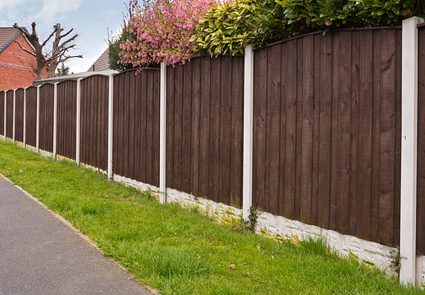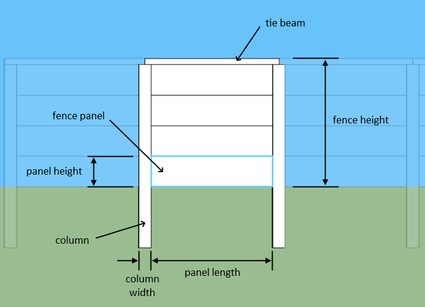Vinyl Fence Calculator
This vinyl fence calculator is a simple tool that provides the number of prefabricated fencing components for a given project. This calculator will help you estimate the materials you need if you are planning on building a DIY fence. Prefab fences are fast, easy to install, and can be assembled by anyone — even someone without expert masonry skills! Read on to learn more about this method and its advantages.
What is a prefab vinyl fence?

Prefab fences are an innovation in construction where parts of the fence or wall are fabricated first at a factory. They are then delivered to the site for assembly. Anyone keen on building things can choose this innovation to build their DIY fence quickly and easily. This method of installing fences is perfect for flat terrains but still does well on sloping terrains. You can visit our elevation grade calculator if you want to learn how to determine a sloping terrain's angle of elevation or elevation grade.
Parts of a simple prefab fence

The parts of a prefab vinyl fence typically include interlocking columns, panels, and beams. Manufacturers use various materials, such as reinforced concrete, metals, wood, and even plastics, to manufacture these prefab components. The manufacturer usually molds them, making their look and dimensions uniform with every fabrication.
Building with a prefab system is much like playing with building blocks. However, instead of using small building blocks, you will have panels that are much larger than even your largest Lego creations. Panels can be as short as a regular hollow block or as tall as the entire height of the fence. At the same time, you can get panels of any length imaginable. The panel's span is simply the distance from one column to another. Having large panels saves us construction time when compared to laying several small blocks one at a time in each layer in each span.
Determining the materials needed
In construction projects, we want to save as much time and money as possible, even during the procurement stage of the materials. For us to effectively do this, we have to make an accurate estimate of the quantity of construction material needed. This vinyl fence calculator is a simple way of calculating an adequate working estimate for any prefab fence project.
To properly estimate the materials needed for our project, we have to consider a variety of variables. For our prefab fence project, we would need the following:
-
Length to be fenced: This is the total linear measurement of where we want our fence to be built. This fence length is usually the perimeter of a property or a boundary line between two properties. It could be a straight line, a curved line, or combinations of both. If you plan to fence a rectangular lot, you can check our perimeter of a rectangle calculator for a guide for determining the perimeter of a rectangle.
-
Your desired fence height: The height of the fence will vary depending on the owner's preferences. Fences vary from waist height to the height of the building's first story. The height of the fence is up to you, but you should check your local code for the maximum height allowed when building fences.
-
The length of the prefab fence panel: Prefab panels also come in a variety of lengths, heights, and thicknesses. Your choice could depend on the availability of the products or your preferred size. Panels can be as short as an arm's length to as long as 3 meters (or even longer). Just take note that although longer panels may make your fence completion faster, these panels can be cumbersome to carry, hence requiring more labor effort. These are things to consider when choosing the appropriate length for your project.
-
Height of each panel: Panel height determines the number of layers you will need to reach your desired fence height.
-
Column thickness or width: The columns (or posts) are the things that support and hold the panels in place. These columns can be grooved so that the panels can be slotted in easily or have a flat surface where we can bolt the panels in place using brackets. Whichever you choose, the column's width plays a vital role since it also takes up additional space along the stretch of the fence.
Estimating our required vinyl fence components
Now that we know the variables we need to consider, we can now proceed to calculate the quantities of each fence component needed to complete our fence. First, let us imagine a portion of the fence. To build a span of the prefab fence, we need two columns to support either side of the panels. On top of the fence, we need to fix everything in place with a tie beam. There are other configurations of prefab fences out there, but this is one of the most straightforward designs we can consider.
With that in mind, we can say that, for one span of our fence, we would need two columns and a tie beam. However, by adding another span, we can see that two adjacent spans share one common column. By extending further, we can understand what happens and how we should consider the rest of the fence. Therefore, a span is from the center of a column to the center of the next column. To be more precise, we can now consider the span to have a half of a column at each end of the panel. This is expressed in the equation below:
span length = 1/2 × (column width) + panel length + 1/2 × (column width)
We can simplify this equation to:
span length = panel length + column width
To complete the entire length of the fence, we need to add at each end two halves of a column. In equation form:
fence length = (number of spans × span length) + 2 × 1/2 × (column width)
Which if we simplify again:
fence length = (number of spans * span length) + column width
By transposing this fence length equation, we can now determine the number of spans in our fence. We can do this by subtracting 1 column width from the entire fence length and then dividing the difference by the sum of one panel's length and one column's width. In equation form:
number of spans = (fence length - column width) / (panel length + column width)
Since we need tie beams to fix each span, we can conclude that the number of tie beams required is equal to the number of spans. In equation form:
tie beams needed = number of spans
Now that we know the number of spans in our fence length, we can calculate the number of panels needed. But first, we have to determine the number of panels needed per span. We can do this by dividing the fence height by the height of the available panel:
layers of panels = fence height / panel height
Now it is just a matter of multiplying the number of spans by the number of panel layers required to get the total number of panels:
panels needed = number of spans × layers of panels
Remember the fence length equation from above? It implied that an additional 1 column was needed at the end of the fence to complete the fence length. Since there is a column for every span, adding one column to the number of spans gives us the total number of columns required. This gives us the formula for determining the number of columns for a given fence length, as shown below:
columns needed = number of spans + 1
Please take note that this formula works best for straight or curved fences or for those fences that have corners exactly at the columns. Having to consider a bend in the middle of a span would require an additional column and would also require the cutting of panels and beams. Nevertheless, you can still use our vinyl fence calculator for the fences with bends. You just have to make some small adjustments in the quantities of columns and panels.
Benefits of using a prefab vinyl fence
To wrap things up, here are some of the advantages of prefab vinyl fences over conventional ones:
-
Because they are prefabricated, you can save time as you don't have to build the fence yourself.
-
Prefab fences are cost-effective because of the time saved during their construction. By shortening construction duration, we minimize labor costs.
-
Due to its ability to be assembled and disassembled, it can, in theory, be transferred to a new location.
-
They are also easy to install and only require knowledge regarding the mixing of concrete for the foundations.
-
Fence panels come in a variety of designs to choose from (depending on manufacturer and supplier).
-
Last but not least, vinyl fences are lightweight yet durable. They are also not going to rot in the presence of moisture, so they are perfect for outdoor fencing.
Want to know more about DIY fences?
You can check our fence calculator if you want to build your own fence. It discusses building conventional fences and calculates the materials needed for your DIY fence. You can also use our baluster calculator or our spindle spacing calculator if you want balustrade fencing for your properties' boundaries. 🙂